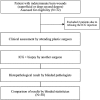Indocyanine green dye angiography as an adjunct to assess indeterminate burn wounds: A prospective, multicentered, triple-blinded study
- PMID: 30589753
- PMCID: PMC6493689
- DOI: 10.1097/TA.0000000000002179
Indocyanine green dye angiography as an adjunct to assess indeterminate burn wounds: A prospective, multicentered, triple-blinded study
Abstract
Background: Clinical assessment of indeterminate burn wounds has been reported to yield poor accuracy, even when performed by burn experts. Indocyanine green (ICG) dye angiography has been found to be highly accurate in assessing burn depth, but there is still limited evidence of its use in indeterminate burn wounds. This study aims to compare the accuracy of ICG angiography to that of clinical assessment in assessing indeterminate burn wounds.
Methods: This is a prospective, multicentered, triple-blinded, experimental study. Participants were stable patients, admitted to the hospital with burn wounds of indeterminate depth. The burn wounds were clinically assessed by an attending plastic surgeon. ICG angiography was performed and evaluated by another surgeon. Tissue biopsies were obtained and sent for histological study to be assessed as the gold standard.
Results: In the 30 burn sites that were assessed, the accuracy of ICG angiography was 100.0%, compared with 50.0% for clinical assessment (p < 0.001). Clinical assessment yielded a sensitivity of 33.3% and specificity of 66.7%, while ICG angiography yielded both a sensitivity and specificity of 100.0%. Therefore, the number needed to treat for using ICG angiography in indeterminate burn wounds was two.
Conclusion: Indocyanine green angiography yields a significantly higher accuracy than clinical assessment in indeterminate burn wounds. This intervention can, thus, be a useful tool to aid clinical judgment.
Trial registration: Thai Clinical Trials Registry, number TCTR20170821001.
Level of evidence: Diagnostic test, level I.
Figures


Similar articles
-
An Inconvenient Truth of Clinical Assessment and Indocyanine Green Angiography Precise Marking for Indeterminate Burn Excision.Plast Reconstr Surg Glob Open. 2021 Mar 24;9(3):e3497. doi: 10.1097/GOX.0000000000003497. eCollection 2021 Mar. Plast Reconstr Surg Glob Open. 2021. PMID: 33777602 Free PMC article.
-
Indocyanine green dye angiography accurately predicts survival in the zone of ischemia in a burn comb model.Burns. 2014 Aug;40(5):940-6. doi: 10.1016/j.burns.2013.10.017. Epub 2013 Nov 11. Burns. 2014. PMID: 24231464
-
The influence of dressings and ointments on the qualitative and quantitative evaluation of burn wounds by ICG video-angiography: an experimental setup.Burns. 2004 May;30(3):232-5. doi: 10.1016/j.burns.2003.10.016. Burns. 2004. PMID: 15082349
-
Burn Depth Analysis Using Indocyanine Green Fluorescence: A Review.J Burn Care Res. 2019 Jun 21;40(4):513-516. doi: 10.1093/jbcr/irz054. J Burn Care Res. 2019. PMID: 31046089 Review.
-
[A new approach for studying the retinal and choroidal circulation].Nippon Ganka Gakkai Zasshi. 2004 Dec;108(12):836-61; discussion 862. Nippon Ganka Gakkai Zasshi. 2004. PMID: 15656089 Review. Japanese.
Cited by
-
A Critical Update of the Assessment and Acute Management of Patients with Severe Burns.Adv Wound Care (New Rochelle). 2019 Dec 1;8(12):607-633. doi: 10.1089/wound.2019.0963. Epub 2019 Nov 6. Adv Wound Care (New Rochelle). 2019. PMID: 31827977 Free PMC article. Review.
-
Indocyanine green angiography processing and analysis pipeline for the assessment of indeterminate burn wounds.J Biomed Opt. 2025 Jun;30(6):065002. doi: 10.1117/1.JBO.30.6.065002. Epub 2025 Jun 23. J Biomed Opt. 2025. PMID: 40552069 Free PMC article.
-
Bedside Fluorescence Microangiography for Frostbite Diagnosis in the Emergency Department.West J Emerg Med. 2022 Oct 23;23(6):872-877. doi: 10.5811/westjem.2022.8.55020. West J Emerg Med. 2022. PMID: 36409932 Free PMC article.
-
Assessing detector stability and image quality of thermal cameras on smartphones for medical applications: a comparative study.Med Biol Eng Comput. 2025 Sep;63(9):2707-2715. doi: 10.1007/s11517-025-03348-4. Epub 2025 Apr 4. Med Biol Eng Comput. 2025. PMID: 40183850 Free PMC article.
-
[Research advances on the techniques for diagnosing burn wound depth].Zhonghua Shao Shang Yu Chuang Mian Xiu Fu Za Zhi. 2022 May 20;38(5):481-485. doi: 10.3760/cma.j.cn501120-20210518-00195. Zhonghua Shao Shang Yu Chuang Mian Xiu Fu Za Zhi. 2022. PMID: 35599424 Free PMC article. Chinese.
References
-
- Güler Gürsu K. An experimental study for diagnosis of burn depth. Burns. 1977;4(2):97–103.
-
- Still JM, Law EJ, Klavuhn KG, Island TC, Holtz JZ. Diagnosis of burn depth using laser-induced indocyanine green fluorescence: a preliminary clinical trial. Burns. 2001;27(4):364–371. - PubMed
-
- Jaskille AD, Ramella-Roman JC, Shupp JW, Jordan MH, Jeng JC. Critical review of burn depth assessment techniques: part II. Review of laser Doppler technology. J Burn Care Res. 2010;31(1):151–157. - PubMed
-
- Sharma VP, O'Boyle CP, Jeffery SL. Man or machine? The clinimetric properties of laser Doppler imaging in burn depth assessment. J Burn Care Res. 2011;32(1):143–149. - PubMed
-
- Engrav LH, Heimbach DM, Reus JL, Harnar TJ, Marvin JA. Early excision and grafting vs. nonoperative treatment of burns of indeterminant depth: a randomized prospective study. J Trauma. 1983;23(11):1001–1004. - PubMed
Publication types
MeSH terms
Substances
Associated data
LinkOut - more resources
Full Text Sources
Medical
Research Materials

